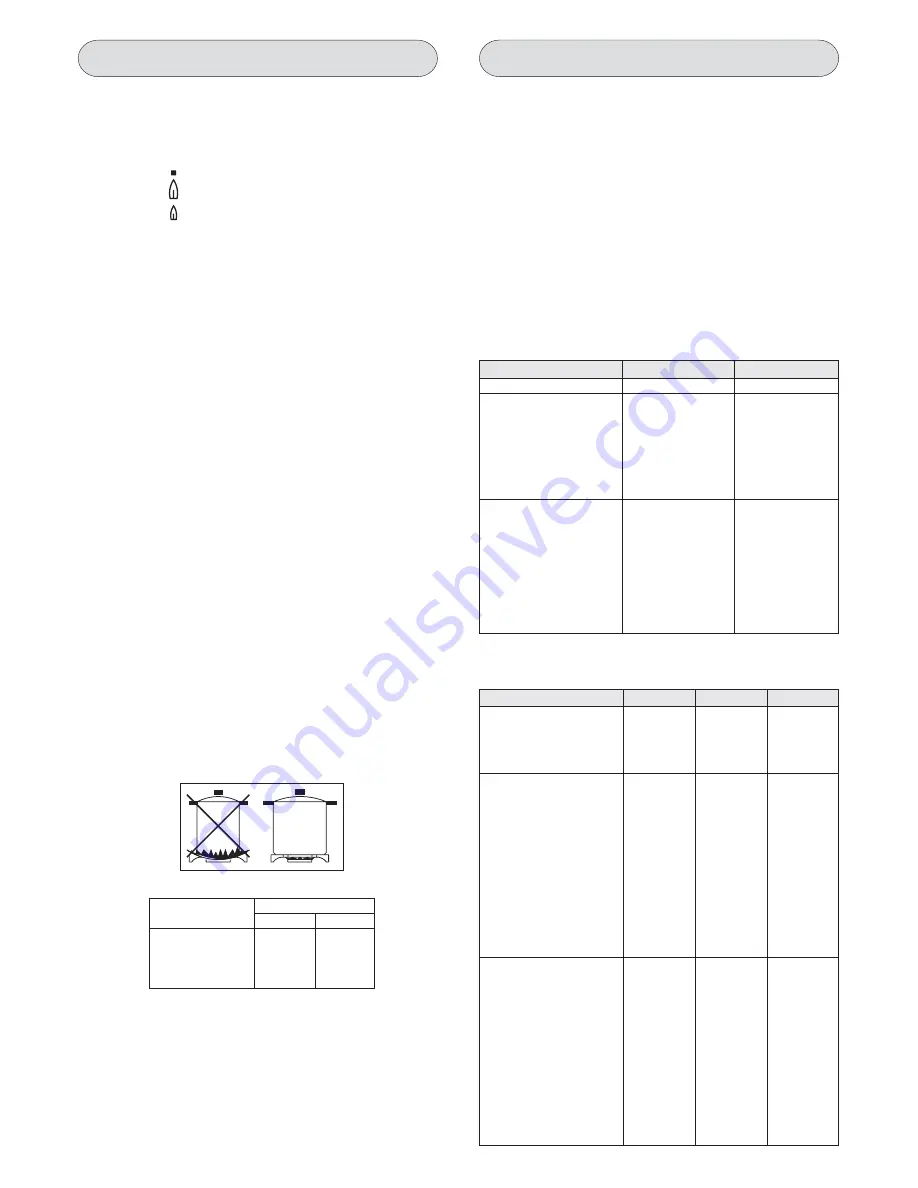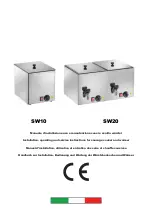
COOK
-TOP USE
USING
THE
GAS BURNERS
The following symbols are
found
on the control panel next to each
knob:
- Circle
gas off
- Large flame
maximum setting
- Small flame
minimum setting
The minimum position is at the end of the anti-clockwise rotation
of the knob.
Knob
positions must be
set
between max. and min.;
never
set the knobs
between max. and off.
AUTOMATIC ELECTRIC IGNITION
To turn
a burner on
, press the knob corresponding to the selected
burner and turn it anticlockwise to the max position. Keeping the
knob pressed, the
burner will automatically ignite
.
In
the event of a power failure
, the burner can also be
lit
using a
match.
SAFETY VALVE
Follow the same procedure described above to ignite the burners.
In this case, however, once you have turned the knob to the open
setting, hold it pressed
down
for 10 seconds.
If for any reason the burner flame goes out, the safety valve
automatically shuts off the gas supply to the burner in question.
ENERGY SAVING TIPS
The diameter of the pan bottom should be the same as that of
the burner. The burner flame must never
exceed
the
pans
diameter.
Use flat-bottomed pans only.
Whenever possible, keep a lid on the pan while cooking.
This allows you cook using less heat
.
Cook vegetables, potatoes, etc. with as little water as possible
to reduce cooking times.
USING
THE ELECTRIC OVEN
The first time the oven is used, it may give off
an
acrid
smell
,
caused by the first heating of
insulating
panels
adhesive
surrounding
the oven
(heat the oven at the maximum temperature for about
30-40 minutes with closed door).
It is
perfectly normal for the oven to smoke when first used;
wait
for the smoke to stop before
placing
food into the oven.
The oven is fitted with: a
grill
shelf for cooking food in oven dishes
or
for placing
directly on the
grill
shelf itself, a drip-tray for cooking
sweets, biscuits, pizzas, etc., or for collecting juices and fats from
food cooked directly on the
grill
shelf.
Note:
The following tables
provide a guid
e for cooking some of
the most
popular
dishes. The cooking times recommended in
these tables are approximate. After a few
attemps
, we are sure
that you will be able to adjust the times to get the results you want.
Conventional cooking table TAB.B
Fan oven cooking table TAB. C.
29
Dish
Temp. °C.
Minutes
Weight kg.
Firs
t
courses
Lasagne
200-220
20-25
0,5
Oven
-baked
pasta
200-220
25-30
0,5
Creole rice
200-230
20-25
0,5
Pizza
210-230
30-45
0,5
Meat
Roast veal
160-180
65-90
1-1,2
Roast pork
160-170
70-100
1-1,2
Roast beef
170-190
40-60
1-1,2
Roast beef joint
170-180
65-90
1-1,2
Roast fillet beef (rare)
180-190
40-45
1-1,5
Roast lamb
140-160
100-130
1,5
Roast chicken
180
70-90
1-1,2
Roast duck
170-180
100-160
1,5-2
Roast goose
160-180
120-160
3-3,5
Roast turkey
160-170
160-240
5 approx.
Roast rabbit
160-170
80-100
2 approx.
Roast hare
170-180
30-50
2 approx.
Fish
160-180
acc. to weight
Sweets (pastries)
Fruit flan
180-200
40-50
Plain sandwich cake
160-180
35-45
Sponge sandwich cake
200-220
40-45
Sponge cake
200-230
25-35
Currant cake
230-250
30-40
Buns
170-180
40-60
Strûdel
160
25-35
Cream slices
180-200
20-30
Apple fritters
180-200
18-25
Sponge finger pudding
170-180
30-40
Sponge finder biscuits
150-180
50-60
Toasted sandwiches
230-250
7
Bread
200-220
40
Dish
Temp. °C.
Minutes
Fish
180-240
acc. to size
Meat
Roast
beef
250
30 per kg.
Roast veal
200-220
30 per kg.
Chicken
200-240
50 about
Duck and goose
220
acc. to weight
Leg of mutton
250
30 per kg.
Roast pork
250
60 per kg.
Soufflés
200
60 per kg.
Sweets (pastries)
Tea-cake
160
50-60
Sponge finger
160
30-50
Shortcrust pastry
200
15
Puff pastry
250
15
Fruit flan
200-220
30
Meringues
100
60
Quiches, etc.
220
30
Quick sponge
120-140
60
Buns
160-180
45
BURNERS
PANS
Ø min.
Ø max
RAPID
180 mm
220 mm
SEMIRAPID
120 mm
200 mm
AUXILIARY
80 mm
160 mm
TRIPLE CROWN
220 mm
260 mm
GB








































